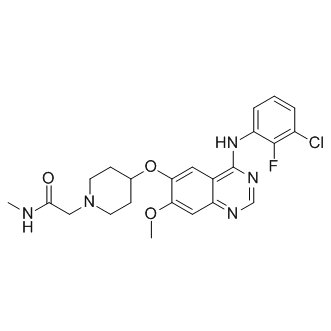| Description: |
Sapitinib (AZD-8931) is a reversible, ATP competitive EGFR inhibitor of with IC50s of 4, 3 and 4 nM for EGFR, ErbB2 and ErbB3 in cells, respectively. |
| Target: |
EGFR:4 nM (IC50)
ErbB2:3 nM (IC50)
HER3:4 nM (IC50) |
| In Vivo: |
AZD8931 (6.25-50 mg/kg, p.o.) significantly inhibits BT474c (breast), Calu-3 (NSCLC), LoVo (colorectal), FaDu (SCCHN), and PC-9 (NSCLC) tumor xenograft growth. AZD8931 is active in xenograft tumor models responsive to EGFR inhibition alone (LoVo and PC-9) or EGFR or erbB2 inhibition (BT474c, Calu-3, and FaDu). AZD8931 causes pharmacodynamic changes in proliferation and apoptosis markers in human tumor xenograft models[1]. AZD8931 (25 mg/kg, p.o.) significantly inhibits the growth of SUM149 and FC-IBC-02 cells in vivo in SCID mice[2]. AZD8931 displays favorable oral pharmacokinetics in rat and dog (low clearance and good bioavailability) and low human hepatocyte turnover (Clint < 4.5 μL/min/106 cells). In nude mouse after oral administration at 50 mg/kg, AZD8931 shows improved exposure, and at at 100 mg/kg oral dose once daily, it shows potent tumor growth inhibition activity in the LoVo mouse xenograft model[3]. |
| In Vitro: |
AZD8931 shows potent inhibitory effect on erbB2 in the ligand-independent MCF-7 cl24 cells, with IC50 of 59 nM[1]. AZD8931 (1 μM) has no significant effect on EGFR expression level, but significantly inhibits phosphorylation of Akt in a time- and dose-dependent manner in both SUM149 and FC-IBC-02 cells. AZD8931 (0.01, 0.1, 1, or 2 μM) inhibits proliferation and induces apoptosis in human IBC cells[2]. At the cellular level, AZD8931 inhibits EGF-stimulated phosphorylation of EGFR in the KB cell line (IC50: 4 nM) and heregulin-stimulated phosphorylation of HER2 (IC50: 3 nM) and HER3 (IC50: 4 nM) in the MCF-7 cell line. However, AZD8931 exhibits no CYP P450 inhibition (IC50 > 10 μM against 1A2, 2C9, 2C19, 2D6, and 3A4)[3]. |
| Cell Assay: |
Cells are incubated for 96 h with a suitable range of concentrations of drug to ensure accurate estimation of the inhibitor concentration required to give 50% growth inhibition (GI50; typically between 0.001-10 μM). Viable cell number is determined by 4 h of incubation with MTS Colorimetric Assay reagent and absorbance measured at 490 nm on a spectrophotometer. Each experiment is carried out in triplicate for each drug concentration and data are presented as geometric means. Sensitivity groupings of GI50 data are <1 μM, 1 to 7 μM, and >7 μM. |
| Animal Administration: |
Swiss nude (nu/nu genotype) and severe combined immunodeficient mice are housed in negative-pressure isolators. Experiments are conducted on 8- to 12-wk-old female mice. All human tumor xenografts are established by s.c. injecting 0.1 mL tumor cell suspension (between 4×106 and 9×107 cells) mixed 1:1 with Matrigel, with the exception of LoVo, which does not include Matrigel, and Calu-3, which uses 30% Matrigel. The BT474c cell line is subcloned from the human breast cell line BT474. For the BT474c model, nude mice are implanted with estradiol 0.36 mg 60-d release pellets 24 h before being implanted with tumor cells. In all models, the animal weight and tumor volumes are monitored twice weekly. Group sizes (n=8-17/group) for each xenograft model are determined by power analysis, and randomization occurred when tumors reach the determined size (>0.2 cm3). AZD8931, lapatinib, and gefitinib are suspended in a 1% (v/v) solution of polyoxyethylenesorbitan monooleate (Tween 80) in deionized water. Animals are given AZD8931 (6.25-50 mg/kg), Lapatinib (100 mg/kg), Gefitinib (100-150 mg/kg), or vehicle control once (qd) or twice daily (bid) by oral gavage. The duration of each study is determined by tumor growth characteristics, with studies ending once tumors reach ~1 cm3. Tumor volume and percentage tumor growth inhibition are calculated and statistical analysis of any change in tumor volume is carried out using a standard t test (P value of lower then 0.05 is considered to be statistically significant). |
| References: |
[1]. Hickinson DM, et al. AZD8931, an equipotent, reversible inhibitor of signaling by epidermal growth factor receptor, ERBB2 (HER2), and ERBB3: a unique agent for simultaneous ERBB receptor blockade in cancer. Clin Cancer Res. 2010 Feb 15;16(4):1159-69.
[2]. Mu Z, et al. AZD8931, an equipotent, reversible inhibitor of signaling by epidermal growth factor receptor (EGFR), HER2, and HER3: preclinical activity in HER2 non-amplified inflammatory breast cancer models. J Exp Clin Cancer Res. 2014 May 30;33:47.
[3]. Barlaam B, et al. Discovery of AZD8931, an Equipotent, Reversible Inhibitor of Signaling by EGFR, HER2, and HER3 Receptors. ACS Med Chem Lett. 2013 May 31;4(8):742-6.
[4]. Wang R, et al. Endothelial Cells Promote Colorectal Cancer Cell Survival by Activating the HER3-AKT Pathway in a Paracrine Fashion. Mol Cancer Res. 2018 Aug 21. pii: molcanres.0341.2018. |






















